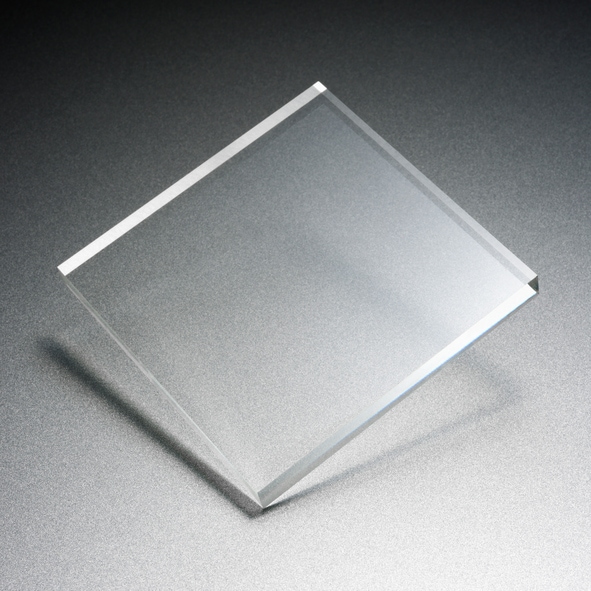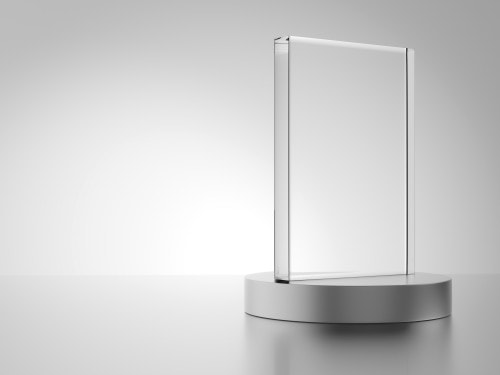Category Archive: Fused Silica
Fused silica and quartz are two commonly employed materials in glass fabrication operations. Both substances offer unique properties that make them suitable for use in fabricated glass components. The following blog post provides an overview of the two, including their composition, key benefits, and typical applications.
Benefits of Fused Silica Glass
 Fused silica is a non-crystalline synthetic material comprised of silicon gas or silica sand. Since it is synthetically processed, it is the purest form of glass on the market, both structurally and physically. Its cross-linked three-dimensional structure results in exceptional thermal resistance and near-zero thermal expansion.
Fused silica is a non-crystalline synthetic material comprised of silicon gas or silica sand. Since it is synthetically processed, it is the purest form of glass on the market, both structurally and physically. Its cross-linked three-dimensional structure results in exceptional thermal resistance and near-zero thermal expansion.
Some of the key benefits of using this glass material include:
- High chemical purity and resistance
- High softening point and strong thermal resistance
- Low thermal expansion and high thermal shock resistance
- High transparency from ultraviolet to infrared spectral range
- High radiation resistance
Benefits of Quartz Glass
Quartz is a naturally occurring crystalline mineral comprised of oxygen and silicon. It is one of the most abundant minerals on the planet and forms in most rock types in the Earth’s crust. When converted into glass, it’s found in applications in many scientific research and other high-tech operations.
Some of the key benefits of using this glass material include:
- Good transmission behavior in the ultraviolet range
- High-temperature endurance in the visible and infrared range
- Low coefficient of thermal expansion and high thermal shock resistance
- Exceptional electrical insulation and high chemical purity
- Suitability for permanent operation at 1100° C or short-term operation at 1300° C
Applications of Fused Silica and Quartz Glass
Both fused silica and quartz glass are ideal for use in many different industrial applications, including the following:
- Chemical and pharmaceutical processes. Chemical and pharmaceutical manufacturing operations experience a wide range of conditions, including exposure to high temperatures, corrosive chemicals, and water. Parts and components made from fused silica and quartz are ideal for use in these environments as they are chemically pure, chemical resistant, non-hygroscopic, and thermal shock resistant.
- Electronics and electro-technology. Electronics and electronic technology rely on both conductive and insulating components. For the latter, fused silica and quartz are ideal as a construction material as they offer low conductivity, high penetration field strength, and low electric loss factor.
- High-temperature operations. The thermal properties of both materials allow them to withstand high processing temperatures without risk of damage or degradation.
- Light and laser technology. Many light-based systems (e.g., lasers) rely on glass optical components—such as ones made from fused silica and quartz—to focus or separate light to perform their operations.
- Optical system components. Fused silica and quartz are used in the manufacture of many optical parts—such as lenses, mirrors, UV and IR transmitting optics, and metrology components—due to their ability to transmit light in the visible, ultraviolet, and infrared range.
- Semiconductors. The purity of the two materials is particularly essential for components such as semiconductors, which play a role in many systems used in critical applications.
- UV light sanitation. UV light sanitation serves as a non-toxic alternative to disinfection. As both fused silica and quartz demonstrate high thermal and radiation resistance, they are suitable for use in equipment subjected to such operations, such as semiconductor components and medical and laboratory instruments.
Fused Silica and Quartz Glass From Swift Glass
At Swift Glass, we have provided quality custom glass fabrication for nearly 100 years. We stock a wide range of fused silica and quartz glasses from a variety of manufacturers, each of which offers unique advantages. For example, our fused silica demonstrates a cross-linked, three-dimensional structure that results in high thermal shock resistance, UV and IR transparency, and near-zero thermal expansion. Some of our other product offerings include:
- Industrial- and commercial-grade fused silica and quartz for sight glasses
- UV-fused silica for applications requiring low content of inclusion and/or high refractive index homogeneity
For additional information about fused silica and quartz or our products and services, contact us or request a quote today.

Fused silica is a glass form of silicon dioxide, a chemical compound that occurs naturally in quartz and many types of sand. Unlike quartz glass, fused silica is entirely synthetic when produced at an industrial level. Typically manufactured using silicon gas, fused silica is the most technically pure glass available.
Fused silica has a non-crystalline structure that lacks long range order at an atomic level — standard for glass materials. Its three-dimensional structure is highly cross-linked, which accounts for its low coefficient of thermal expansion and high use temperature. Its superior ultraviolet (UV) properties, such as UV transmission, are a result of the specialized methods used for its production.
 Thermal Properties
Thermal Properties
Due to its chemical composition and production method, fused silica exhibits excellent thermal properties, most notably a low coefficient of thermal expansion that varies little over different temperature ranges.
Coefficient of Thermal Expansion
From -100 °C (-148 °F) to +200 °C (392 °F), fused silica’s thermal expansion coefficient averages at 0.48 x 10-6/K. Focusing that temperature range slightly, its coefficient in the 5 °C (41 °F) to 35 °C (95 °F) temperature range is an average of 0.52 x 10-6/K. At a higher temperature range, from 0 °C (32 °F) to 200 °C (392 °F), the coefficient is an average of 0.57 x 10-6/K.
Such a low coefficient of thermal expansion across all temperature ranges also allows for a very high resistance to thermal shock, making fused silica glass ideal for applications that experience temperature fluctuations. By comparison, the lowest known coefficient of thermal expansion among metals, found in a nickel-iron alloy, is twice that of fused silica’s.
Thermal Conductivity
When measured at ambient temperatures of 25 °C (77 °F), fused silica has a thermal conductivity of only 1.38 W/(mK). Among the lowest thermal conductivities of known solid materials, this makes fused silica glass an excellent choice for thermal insulation applications.
By comparison, the above-mentioned nickel-iron alloy has a thermal conductivity about 10 times lower, at 10.5 W/(mK). Standard silicon’s is 100 times lower, at 148 W/(mK).
Optical Properties
Fused silica also exhibits strong optical properties, particularly in the infrared and ultraviolet regions of the light spectrum. These properties can be affected by both the purity of the material and the manufacturing process, so some variation does occur; these variations can even be intentionally introduced, depending on the desired end use of the glass.
Key Traits and Benefits
Fused silica is a strong, highly pure material with the strongest temperature-related characteristics of any glass available; it also features excellent optical transmission properties, especially in the ultraviolet spectrum. Aside from the coefficient of thermal expansion, thermal shock resistance, and transparency properties discussed above, fused silica glass also features:
- Strong chemical inertness
- Ability to be lapped or polished to very fine finishes
- Low dielectric constant and loss
To learn more about fused silica and other popular types of glass, download our Glass Material Properties Chart.

If your project demands high performance material, you may have more options than you think. Quartz, Fused Quartz and Fused Silica are all part of an extremely pure family of materials with high working and melting temperatures and superior optical properties as well as low coefficient of expansion.
While they’re often used interchangeably, the fundamental structures and creation of quartz and fused silica are different. Both are highly specialized, but their particular performances vary.
Quartz
Quartz is a very versatile, naturally occurring substance with good electrical, optical and thermal performance and corrosion resistance. In production, quartz glass or fused quartz is created from grains of natural material that are melted and purified.
Key Traits
- Crafted from naturally occurring crystalline quartz or silica grains
- Amorphous
- Non-crystalline product
- Retains some residual impurities from raw material (affects ultraviolet transparency)
- Low OH content
Fused Silica
Fused Silica is an entirely synthetic material, and is technically the purest glass. It has the highest temperature characteristics of any glass, and it often begins as pure silicon gas. Because of the way fused silica is made, it has superior ultraviolet performance to natural quartz and is ideal for applications such as UV transmitting optics.
Key Traits
- Crafted from silicon gas or silica sand (non-crystalline)
- Amorphous
- Cross-linked, 3D structure
- Significant transparency into deep ultraviolet
- Retains some residual impurities from water vapor in processing (affects infrared transparency)
High Performance Materials at Swift Glass
Both of these materials are ideal for semiconductor fabrication, technical and laboratory equipment. Distinctive features they share include:
- Extremely low coefficient of expansion (very shock resistant)
- Extremely high temperature resistance
- Exceptional optical transmission
The Swift Glass Team specializes in custom work, and we’re proud to maintain a vast material inventory. Having a wide range of choices makes it easy to find the perfect glass for your next project, but it also requires careful consideration and attention to subtle qualities.
Remember to evaluate the key traits you need, even once you’ve narrowed your search to a high-performance material:
- Thickness
- Normal Service Temperatures
- Extreme Service Temperatures
- Maximum Temperature, Thermal Shock
- Maximum Temperature, Thermal Gradient
- In/In/F Coefficient of Thermal Expansion
We stock a range of quartz and fused silica glasses from different manufacturers, each with its own particular strengths. Check our online resources and eBooks to learn more, or call the team for more insight — we’ll find just the right glass for your next project.
 Fused silica is a non-crystalline synthetic material comprised of silicon gas or silica sand. Since it is synthetically processed, it is the purest form of glass on the market, both structurally and physically. Its cross-linked three-dimensional structure results in exceptional thermal resistance and near-zero thermal expansion.
Fused silica is a non-crystalline synthetic material comprised of silicon gas or silica sand. Since it is synthetically processed, it is the purest form of glass on the market, both structurally and physically. Its cross-linked three-dimensional structure results in exceptional thermal resistance and near-zero thermal expansion.


 Thermal Properties
Thermal Properties


